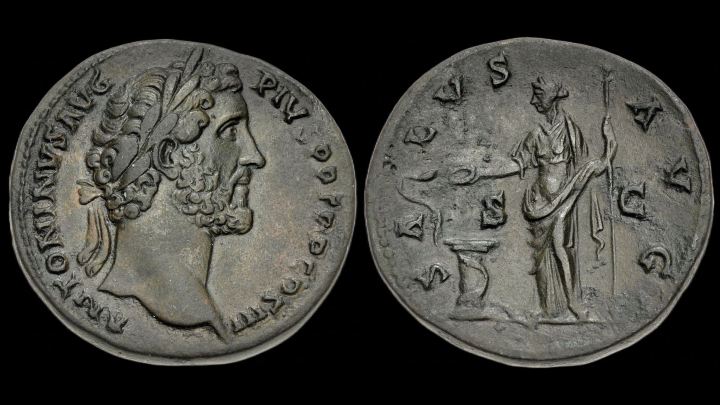Within the vast panorama of Roman imperial coinage, some coins stand out not only for their aesthetic appeal but also for the political message they carry. This sestertius of Antoninus Pius, featuring the goddess Salus on the reverse, is one such piece. A symbol of continuity, well-being, and legitimacy, it reflects a rare moment of stability in the history of the Roman Empire.
A Bronze Coin Reflecting a Peaceful Reign

Struck in Rome under the reign of Antoninus Pius, this sestertius measures 33 mm in diameter, weighs 23.43 g, and has a die axis of 11h. It is preserved in near Extremely Fine (EF) condition, with a beautiful and consistent brown patina that enhances the relief on both the obverse and reverse.
🔸 Obverse:
The inscription ANTONINVS AVG PIVS P P TR P COS III encircles a laureate bust of Antoninus facing right.
This portrait, calm yet resolute, conveys the image of a wise emperor committed to dynastic continuity and administrative stability. The mention of his third consulship (COS III) allows the coin to be precisely dated to around AD 141–143.
🔸 Reverse:
The reverse features Salus, the Roman goddess of public health and the state's well-being. Draped and standing to the left, she feeds a snake coiled around an altar with a patera in her right hand, and holds a vertical scepter in her left. The legend SALVS AVG underscores her role in safeguarding the health of the emperor and the Empire.
The letters S C in the field (Senatus Consulto) indicate that this issue was minted with the Senate's authorization, in keeping with republican tradition.
This reverse design perfectly illustrates Antoninus' desire to emphasize the health, religious harmony, and political stability of his peaceful reign.
Antoninus Pius: Peace Through Continuity
Antoninus Pius ruled from AD 138 to 161 — a period often referred to as a golden age. As the adopted son of Hadrian and adoptive father of Marcus Aurelius, he was one of the few Roman emperors to reign without initiating offensive wars. His tenure was marked by legal reform, provincial development, and a deeply rooted sense of piety.
The choice of Salus as the central figure on this bronze sestertius was no accident. It reflects a clear intention to reassure the Roman people — to show that the emperor’s health was stable and that Rome was protected not only by the gods but by a trustworthy, competent administration.
This coin type fits into a broader political narrative of continuity, while also reinforcing the role of the imperial cult as a unifying social and religious force.
A Historic Sestertius for a Refined Collection
This sestertius of Antoninus Pius combines symbolic power, artistic finesse, and excellent preservation. Acquired from Saslow Rare Coins in 1983, it comes from a private collection and was sold for $2,250 (approx. €1,940).
t stands among the finest examples of 2nd-century imperial monetary propaganda and remains a must-have for any collector interested in the intersection of piety, policy, and coinage.
📩 Looking for this coin — or another one, Contact us, and we’ll find it for you.